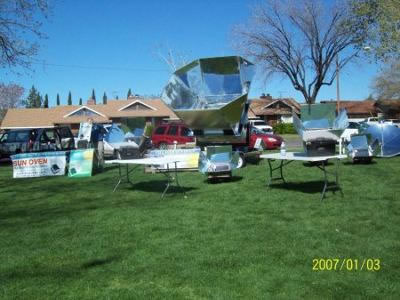Talking about Solar Cooker Temperature
by Jim La Joie
(Bonsall, CA)
Thoughts on Solar Cooker Temperature.
The most frequently asked question at any solar cooking show is “How hot does it get?”
This simple question is a little misleading because the value of temperature alone will not reveal the cooking ability of a solar cooking device.
Temperature achieved must be “weighted” by the size of the cooker. A small magnifying glass can achieve very high temperature, but is of little use for cooking. A small parabolic can achieve a very high temperature but, again, it is of little use for cooking.
A more accurate method of stating a solar cooker’s capacity would be to use the same calculation as is used for electrical power. Volts x Amps = Watts (power)
For solar cookers Volts= Temperature, Amps= insolated area. (Definition of Insolation:1. exposure to sunlight: exposure of something to sunlight
2. rate of solar radiation: the rate of solar radiation received per unit area)
So a one thousand square inch cooker produces 2 times the power of a 500 square inch cooker if both achieve the same temperature.
Here in California there is a very large trailer mounted solar oven. It cooks a lot of bread at one time - but it does not cook any faster than a smaller oven cooking a single loaf. The large oven and the small oven both achieve the same temperature, but the large oven has greater power because of its greater insolated area.
The relationship of size to cooking power (not just temperature) is very clear. For any given design, the larger the insolated area, the greater the power.
Bottom line is this: A small cooker only collects a small amount of sunlight. No matter how good the design, no matter how great the maximum achieved temperature, the small cooker is appropriate for small quantities only. If you need to cook a lot of food, use more than one cooker or use a cooker that collects more sunlight.
____________________________________________
Hi Jim,
Great definition and explanation!
This will definitely be very helpful to our site visitors. I too get the same "how hot" question all the time.
Thank you very much.
P.S. I took the liberty of adding the definition of insolation so that people would know what it meant, and a photo of the big Villager oven.
Nathan
Admin
Comments for Talking about Solar Cooker Temperature
|
||
|
||
|
||
|
||
|
||
|
||
|
||
|
||
SOLAR COOKER CATEGORIES
Panel Cookers
Box Cookers
Parabolic Cooker
Evacuated Cookers
Accessories
Discontinued CookersNew Financing Options available for purchase of Solar Cookers



